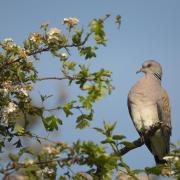Tunbridge Wells artist Sian Bennett’s was first inspired to paint by the work of Botticelli and her own style is a mix of abstract and figurative

Sian Bennett works from a studio in the converted Victorian industrial building which houses Creek Creative in Faversham’s town centre. She has been here for about three years, based previously at her small studio at home in Tunbridge Wells. Sian studied Fine Art and Painting at Camberwell School of Art, where she attained a BA, and believes that a formal art training is important. “It teaches you to observe the world and drawing and sketching is a very important element of my painting and thinking,” she says.
Living in London, she was able to spend many hours drawing exhibits in the British Museum, where she was particularly interested in Greek and Roman sculpture and enthuses: “It’s great to see that drawing is encouraged there”
During this period of living and working in London, she created mainly pastels of people in different work environments, with Tate and Lyle and the Express Dairies among her clients.
I found a touch of Fernand Leger in her work, with his massive industrial figures, or Prunella Clough, but without her palette of muddy colours.

However, it is to Botticelli that she attributes her epiphany of wishing to paint. “I was 13 when I looked at an art book on Botticelli and I knew that I wanted to paint then. I started copying the pictures with all the enthusiasm of a 13 year-old and soon realised there was a long way to go!”
Sian likes to work in acrylics because “they can be layered and used very thinly almost as a watercolour, but also can be used very thickly, so there is a wonderful variety of texture available. Acrylic paints can have a luminous, pulsating quality that is achieved with thin, watery paint”
She also uses paper and tissue paper, in collage “to explore ideas” and says her work “oscillates between abstraction and figurative work, often combining the two.”
Sian may choose a subject which resonates with her inner feeling at the time. “I then explore it with sketching. If I feel the resonance is still there, I continue on and further the exploration. Usually the subject gets increasingly interesting and offers up rich possibilities, which then lead to a series of paintings.”
She works on several pieces at a time but they are usually related in concept and idea. The problems, she admits, are those of attaining the required expression of “inner feeling, combined with the technical demands of making good painting which involves composition, design, form, colour harmony and is like an orchestra in which everything has to work together to make a whole.”
In preparing for new projects, Sian creates many sketches in pencil or biro of what she finds interesting. “I see what emerges from it. It could be a feeling evoked, a smell that triggers a memory or a play of colours or light and shade.”
As she works on several paintings and collages at a time, inspired by the same initial thought, she may leave a work and come back to it. “One piece could take several weeks or months or something may come together in a day, if I have done a lot of preparatory work.”
Sian says the most exciting piece of work she had created is always the piece she is currently working on and her inspiration is “anything and everything around me. For example, I was watching the rain the other day and that inspired a painting.”
Indeed, if she was only restricted to one colour she’d choose grey, because it has so many shades and hues.
The shade Payne’s grey is attributed to William Payne who lived in 19th-century Devon and had to depict the weather conditions of fog, mist and rain. His grey was a mix of Prussian blue, yellow ochre and crimson lake, and he was very proud of it.
Sian herself creates grey through a mix of ultramarine and burnt Sienna, which she tells me is more pinky than Payne’s grey, which is slightly more yellowy.
Painting is a language and a way to draw attention to the deep realities of life that are often ignored,” says Sian.
She adds: “A young artist should follow the dream, there’s always a way through somehow, and if you don’t you might always wonder what might have been.”
Get in touch:
Contact Sian on her mobile 07516 773949: studio visits welcome, Tuesday to Sunday 10am to 4pm, by appointment.
Visit Sian’s website: www.sianbennettfineartist.co.uk



























